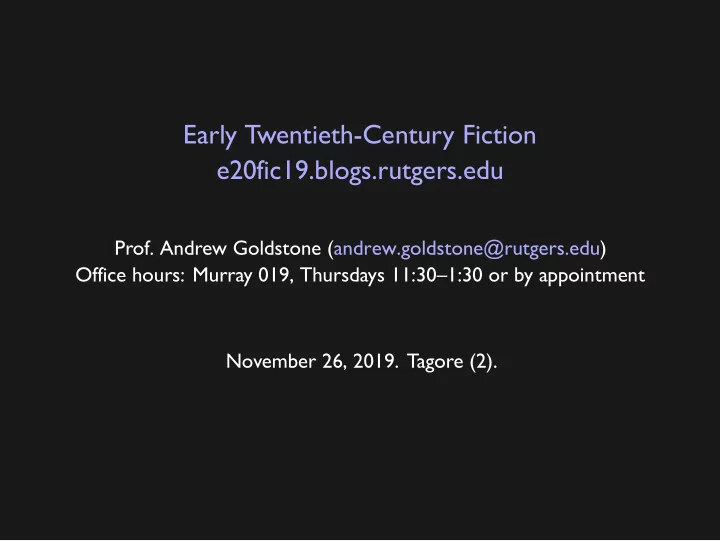

Early Twentieth-Century Fiction e20fic19.blogs.rutgers.edu Prof. Andrew Goldstone (andrew.goldstone@rutgers.edu) Office hours: Murray 019, Thursdays 11:30–1:30 or by appointment November 26, 2019. Tagore (2).
within and beyond English: Bengal Renaissance 1828 Brahmo Samaj founded by Ram Mohan Roy and Tagore’s grandfather 1861 Michael Madhusudan Dutt, Meghnādavadha kāvya (epic) 1864 Bankimchandra Chatterjee, Rajmohan’s Wife (English novel) 1880 Tagore, Evening Songs (Bengali debut volume) 1905 Rokeya Sekhawat Hussein, “Sultana’s Dream” (English utopian story) 1929 Bibhutibhushan Banerjee, Pather Panchali (Bengali novel)
If a Western literature should turn to this extraordinary literature in Ben- gali [the Bengal Renaissance] and expect to find some sort of simple re- sponse to colonialism, he or she will be disappointed; the response is complex, subtle, varied and profound; the colonial world is represented, in these fictions, as history, contemporaneity, memory and change, by, for instance, the post office and the railways, by the names of roads, by pro- fessions, and old and new ways of life, rather than the figure of the British oppressor. This peripherality of the Western figure might be unsettling to the Western reader. Amit Chaudhuri, “Modernity and the Vernacular,” in The Vintage Book of Modern Indian Literature (New York: Vintage, 2004), xix–xx.
“to see the universal being” World literature [ viśva-sāhitya ] is not merely the sum of your writings, plus my writing, plus his writings. We generally see literature in this limited, provincial manner. To free oneself of that regional narrowness and re- solve to see the universal being in world literature, to apprehend such totality in every writer’s work, and to see its interconnectedness with every man’s attempt at self-expression—that is the objective we need to pledge ourselves to. Tagore, “Visva Sahitya” (1907), trans. Rijula Das and Makarand R. Paran- jape, in Rabindranath Tagore in the 21st Century , ed. Debashish Banerji (New Delhi: Springer India, 2015), 286, 288.
the universal, particular versions ▶ Consider the four translations of the ending of “The Postmaster” on the handout. Locate a detail in the Mitter, Radice, or Chaudhuri version that is distinctive: think especially about the possible stances towards the characters that the versions imply.
Are ghosts real? Consider how the story spells out the consequences for giving one answer or another. “The Hungry Stones”
“The Hungry Stones” ▶ Are ghosts real? Consider how the story spells out the consequences for giving one answer or another.
systems of opposition present past tax-collecting palace recreation Rs. 450/month Mughal luxury world of men world of women sola hat paijamas India Persia, Arabia comedy desire reality illusion illusion reality
Call it reality or dream, the momentary glimpse of that far-off world, 250 years old, vanished in a flash. The mystic forms that brushed past me with their quick unbodied steps, and loud, voiceless laughter. (9) That I….should be drawing a monthly salary…appeared to me such an astonshingly ludicrous illusion that I burst into a horse-laugh. (11) My short English coat and tight breeches did not suit me in the least. (15–16) Who am I? (19)
another opposition present past tax-collecting palace recreation Rs. 450/month Mughal luxury world of men world of women sola hat paijamas India Persia, Arabia comedy desire reality illusion illusion reality frame narrator inner narrator?
next ▶ Anand, Untouchable (all of it) ▶ commonplace: group B. ▶ How does Anand represent the worker as a worker?
Recommend
More recommend